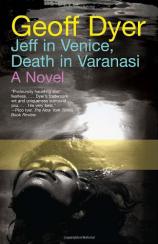Jeff in Venice, Death in Varanasi
Review
Jeff in Venice, Death in Varanasi
Geoff Dyer’s fourth work of fiction is a brilliantly
bifurcated exploration of the emotional poles of sensual pleasure
and spiritual quest. It’s a smart, funny, eyes-wide-open take
on our search for meaning, one of those rare novels that begs to be
read again the moment you have turned to the final page.
In the novel’s first half, “Jeff in Venice,”
Dyer introduces Jeff Atman (in a sly nod to the second part of the
book, the word means “soul” or “true self”
in Hinduism), a cynical 45-year-old British journalist who has just
dyed his hair for the first time and taken off for Venice. He is
headed there on assignment to cover the Biennale and write a piece
on the ex-girlfriend of a prominent artist (the latter a task he
bungles spectacularly). Jeff seems more intent on sampling the
pleasures of the Italian city (a torrent of bellinis and
never-ending helpings of risotto the most prominent). There, he
meets Laura Freeman, a ravishing young woman who works for a Los
Angeles art gallery. The two zip around the city’s waterways
on its fleet of vaporettos and quickly tumble into a relationship
that features copious bouts of sex (described in NC-17 detail) and
cocaine, interspersed with a mind-numbing swirl of parties and
gallery visits.
Astonished by the ample, unanticipated pleasures of his
encounter with Laura, Jeff strides the streets, dumbly celebrating
his good fortune: “He swaggered through Venice as if he owned
the place, as if it had been created entirely for his benefit.
Life! So full of inconvenience, irritation, boredom and annoyance
and yet, at the same time, so utterly fantastic.” Though it
seems the two have made a connection that transcends the purely
carnal, Laura departs for Los Angeles after three magical, if
inexplicable, days. They enact the obligatory exchange of email
addresses and phone numbers, and we’re left with a feeling
that seems both inevitable and somehow fitting that they’ll
never see each other again.
The second section of the book, recounted in the first person by
an unnamed narrator with enough similarities to Jeff to let us
conclude it’s the same protagonist, is set in India’s
holy city of Varanasi, on the banks of the Ganges River. After
polishing off the magazine piece that has brought him there, the
narrator abandons any plan to return home, slowly adapting to the
rituals and rhythms of the ancient city (“I’d come to
Varanasi because there was nothing to keep me in London, and I
stayed on for the same reason: because there was nothing to go home
for.”). But as he does so, he undergoes an emotional
transformation that becomes more profound as time glides past like
the spiritually pure, dreadfully polluted Ganges. “All
I’m saying,” he concludes, “is that in Varanasi I
no longer felt like I was waiting. The waiting was over. I was
over. I had taken myself out of the equation.” He shaves his
head, dons a dhoti and in one of the most striking demonstrations
of Dyer’s art, we ponder whether “Jeff” is
evolving toward some higher plane of spiritual ecstasy or
descending into the depths of madness.
The novel is suffused with a sharp, picturesque description of
its disparate yet strikingly similar settings. “Every day,
for hundreds of years,” Dyer writes, “Venice had woken
up and put on this guise of being a real place even though everyone
knew it existed only for tourists.” Varanasi, with its
ubiquitous ghats and their cremation pyres, is drenched in an
almost hallucinatory swirl of colors, sights and smells: “The
colours made the rainbow look muted. Lolly-pink, a temple pointed
skywards like a rocket whose launch, delayed by centuries, was
still believed possible, even imminent, by the Brahmins lounging in
the warm shade of mushroom umbrellas.”
Given the superficially unconnected stories, it’s fair to
ask whether the work really is a “novel,” or, more
correctly, two novellas with interwoven themes. Regardless, the
effort of teasing out the links between the two sections is one of
the book’s numerous pleasures. To start, both are set in
watery cities steeped in history. And with a deft touch, the
stories’ language and images echo each other, illustrated by
this handful of many such examples: begging bowls, real and
metaphorical appear in both cities; the term “otter”
does double duty as the way Jeff hears Venetians describe the heat
and how “Jeff” imagines his “sleek”
appearance at the end of the novel; there’s an image of a
kangaroo that surfaces at the climax of both stories; and
Jeff’s Venice dream of having his arm devoured by a dog
becomes frighteningly real when that fate befalls a corpse in
Varanasi.
Strikingly contemporary and utterly timeless, JEFF IN VENICE,
DEATH IN VARANASI is an intense, vivid trip to a pair of exotic
cities and an equally provocative journey into the twisted
passageways of the human soul.
Reviewed by Harvey Freedenberg (mwn52@aol.com) on January 22, 2011
Jeff in Venice, Death in Varanasi
- Publication Date: April 6, 2010
- Genres: Fiction
- Paperback: 304 pages
- Publisher: Vintage
- ISBN-10: 0307390306
- ISBN-13: 9780307390301




